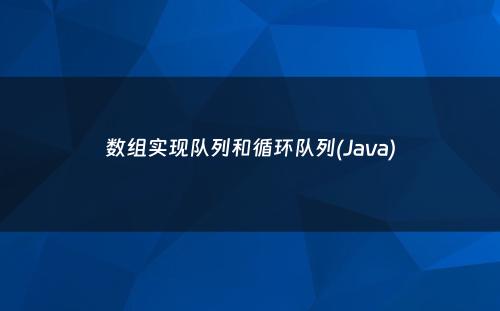
如何理解“队列”
- 操作受限的线性表数据结构:先进先出
- 最基本的操作:入队和出队
- 队列分为队头和队尾,在队尾插入数据(入队),在队头删除数据(出队)。
用数组实现的顺序队列
- 思路:使用两个指针,一个head指针指向队头,一个tail指针指向队尾。
- 代码?
// 用数组实现的队列public class ArrayQueue { ?// 数组:items,数组大小:n ?private String[] items; ?private int n = 0; ?// head 表示队头下标,tail 表示队尾下标 ?private int head = 0; ?private int tail = 0;? ?// 申请一个大小为 capacity 的数组 ?public ArrayQueue(int capacity) { ? ?items = new String[capacity]; ? ?n = capacity; }? ?// 入队 ?public boolean enqueue(String item) { ? ?// 如果 tail == n 表示队列已经满了 ? ?if (tail == n) return false; ? ?items[tail] = item; ? ?++tail; ? ?return true; }? ?// 出队 ?public String dequeue() { ? ?// 如果 head == tail 表示队列为空 ? ?if (head == tail) return null; ? ?// 为了让其他语言的同学看的更加明确,把 -- 操作放到单独一行来写了 ? ?String ret = items[head]; ? ?++head; ? ?return ret; }}- 代码存在问题:随着不停地进行入队、出队操作,head 和 tail 都会持续往后移动。当 tail 移动到最右边,即使数组中还有空闲空间,也无法继续往队列中添加数据了。
- 代码优化思路:在tail移动到最右边时,判断head是否为0,如果是0,说明队列已满,如果不是,说明队列未满,此时进行一次队列的迁移,队列从head到tail整体迁移到从0开始。
- 优化代码
// 入队操作,将 item 放入队尾
public boolean enqueue(String item) {
// tail == n 表示队列末尾没有空间了
if (tail == n) {
// tail ==n && head==0,表示整个队列都占满了
if (head == 0) return false;
// 数据搬移
for (int i = head; i < tail; ++i) {
items[i-head] = items[i];
}
// 搬移完之后重新更新 head 和 tail
tail -= head;
head = 0;
}
items[tail] = item;
++tail;
return true;
}
使用循环队列避免数据搬移操作
- 顾名思义,就是对队列的收尾是连接的,并不是真的像循环链表一样首尾连接,而是有相同的效果。
- 使用数组实现思路:数组实现队列,就是通过两个链表来访问数组,实现先进先出的效果。所以在入队和出队时,把控好数组的下标的变换即可实现循环队列的效果。所以需要了解判断队满的情况指针变换的情况。
- 思考:队列长度为n队满的情况(针对队尾):循环队列不能再使用tail等于n来判断是否有队满的可能。此时,因为是循环队列,由于其循环进行入队和出队的操作的特殊性,当队满时,队列就是全部被填满的,所以此时,出队和入队指针指向的值的和为n-1.(也可以用表达式(tail+1)%n==head)队空的情况(针对队头):不变,依然是head == tail时为队空。指针变换的思考:不考虑队满和队空时,head和tail指针需要在等于n-1时,下一次变换为0.所以,可以使用一个判断或者使用+1整除n。
- 代码
public class CircularQueue {
// 数组:items,数组大小:n
private String[] items;
private int n = 0;
// head 表示队头下标,tail 表示队尾下标
private int head = 0;
private int tail = 0;
// 申请一个大小为 capacity 的数组
public CircularQueue(int capacity) {
items = new String[capacity];
n = capacity;
}
// 入队
public boolean enqueue(String item) {
// 队列满了
if (tail + head + 1 == n) return false;
items[tail] = item;
tail = (tail + 1) % n;
return true;
}
// 出队
public String dequeue() {
// 如果 head == tail 表示队列为空
if (head == tail) return null;
String ret = items[head];
head = (head + 1) % n;
return ret;
}
}


本文暂时没有评论,来添加一个吧(●'◡'●)